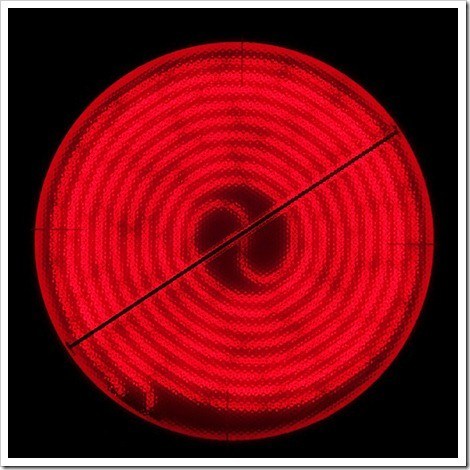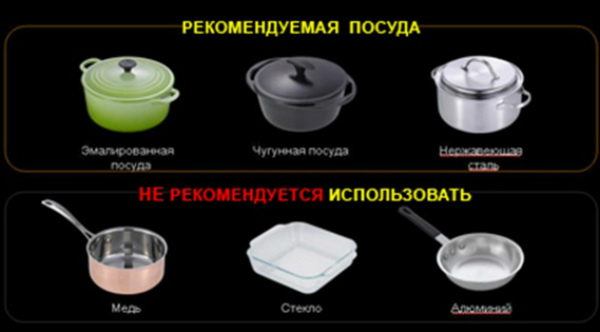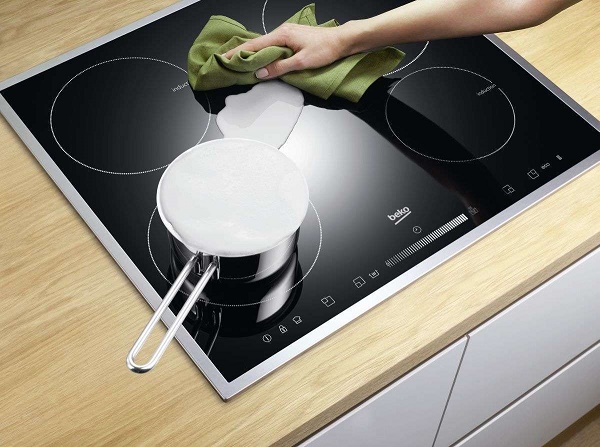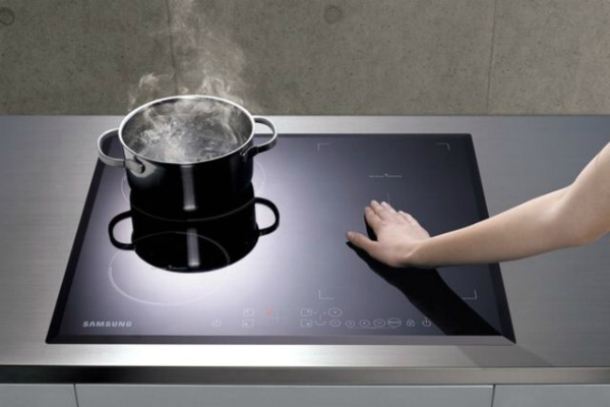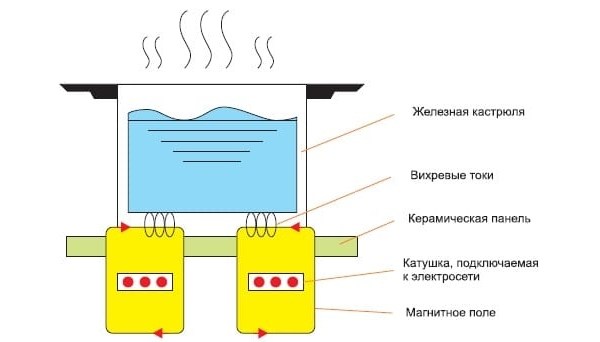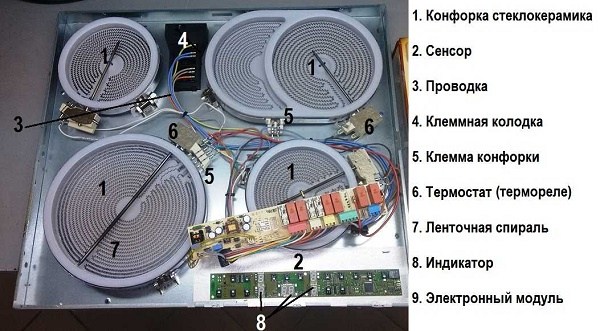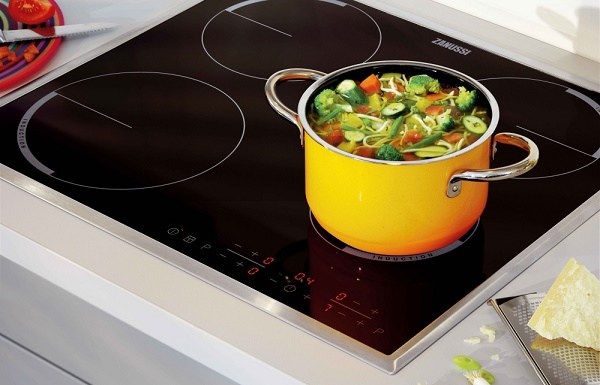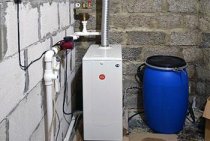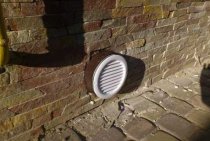Varieties of burners for glass-ceramic electric stoves
I will list the known methods of heating that glass ceramics can hide underneath in order of increasing energy efficiency, but this does not mean at all that the latter will be the best. Let's not forget the fundamental purpose of any hearth, cooking delicious food, and speed in this process is not always needed.
Rapid burners
Now it is the most common type of heating element for glass-ceramic stoves. They heat up in 10-12 seconds. Of course, due to low efficiency and high thermal inertia, these heating elements are far from perfect, but the ability to maintain the temperature in the widest range and good maintainability to some extent compensates for the shortcomings.
Band heating element
High light technology. Advantages:
- Speed of heating of a working zone 4-7 sec.
- Suitable dishes from any material.
Disadvantages: low efficiency and, as a result, high power consumption, rather high thermal inertia.
Halogen cookers
Halo Light technology uses halogen lamps as a heating element. Plates are marked with the letter “H” (Halogen). Advantages of this method:
- High efficiency of 68%.
- Wide range of adjustable temperatures. Of course, this range is different for different models, but believe me, it is quite wide.
- Rapid heating of the working area, 5-7 sec.
- Suitable for any cookware.
Flaws:
- Noise from the cooling fan.
- Relatively short life of halogen lamps (about 2000 hours). This is probably the main drawback of this heating method. In addition, finding an analogue of a burned-out lamp will be problematic.
The infrared rays emitted by the lamp will heat everything that gets in their way. Of course, a one-time contact will not appear on surrounding objects in any way, but if you cook on such a stove all the time, then over time it will be noticeable that the exposed skin areas are visibly tanned. I don’t know which category to classify this property as, advantages or disadvantages, but women definitely won’t like it.
Combined heating methods
There are various very intricate combinations. For example, the apparatus of the Candy TRIO series, which combines in one case: a hob with four belt and one halogen burners, an oven and a dishwasher. There are simpler configurations, gas + electric burners (Darina KM341). Hob with gas burners combined with an electric oven (Hansa FCMW58221).
Induction and glass ceramics pros and cons
The difference between induction and glass-ceramic models, of course, exists. And every consumer who chooses a technique is looking for an acceptable combination of advantages and disadvantages.
Induction surfaces
The following indicators can be called the advantages of the induction model.
- Safety. A noteworthy option to prevent the occurrence of a fire is to automatically turn off when the dishes are removed from the hob. It should be recalled that the electromagnetic field heats only the bottom of the dish, which has ferromagnetic qualities, which prevents burns.
- Practicality. The advantage is manifested in the cleaning of equipment. The soiled area can be washed immediately, without waiting for the end of cooking or the moment when the panel becomes cold.
- Profitability. Considering the cost of electricity consumed, the induction cooker is more economical.
Among the shortcomings can be noted the need to purchase specialized dishes. The induction hob will only work with pots (pans, kettles) containing ferromagnetic alloys. It should be noted that such dishes are often used even before the purchase of an induction cooker.
Advice! Due to the difficulty usually encountered when finding the right pan for frying, most manufacturers complete the plates with a special magnet that checks the cookware before purchase.
Therefore, when choosing an induction hob, you should pay attention to this. The most important disadvantage of the induction hob at the moment is its high cost.
The most important disadvantage of the induction cooker at the moment is its high cost.
Stove Galaxy GL3053 on Yandex Market
Plate Kitfort KT-107 on Yandex Market
Stove Galaxy GL3054 on Yandex Market
Glass-ceramic surfaces
The advantages of glass-ceramic hobs are as follows:
- they have more loyal requirements for the selection of dishes;
- such panels allow you to finish cooking using residual heat, thanks to rapid heating and long cooling;
- glass-ceramic surfaces favorably differ in cost, which is the most important plus in comparison with induction analogues.
The disadvantages of glass ceramics include the fragility of the equipment. The surface easily copes with high static pressure, but does not withstand the impact of sharp and heavy objects. As a result, chips and cracks can form, which can affect the performance of the equipment.
The panel is also impractical to maintain. It is recommended to care for the surface only with products without abrasive particles, otherwise scratches may appear that will affect the aesthetic appearance of the equipment. Unlike the induction model, all dirt, grease and food residues should be removed immediately after cooking.
Advice! It is not recommended to use dishes made of ceramics and glass, as they have a low thermal conductivity. Utensils made of aluminum and copper are also contraindicated - it leaves damage on the surface of the burners. An exception in this case is the infrared stove, which also has a glass-ceramic coating and allows the use of any dishes.
All preferences in favor of induction panels or glass-ceramic panels are very relative.
Which electric stove to choose should be decided, taking into account the conditions of use, the availability of the necessary functions and, of course, personal preferences. It is especially recommended to choose equipment from among proven manufacturers, which guarantees quality and high service.
Caso Comfort C 2000 cooker on Yandex Market
Cooker Hansa FCCX58235 on Yandex Market
Stove Gorenje EC 53 INB on Yandex Market
Article added: June 17, 2018 at 07:39
Print article
Article Rating:
Induction cooker is harmful to health
Is an induction hob harmful to health?
In the study and detailed analysis of this type of hobs, scientists concluded that induction cookers do not harm health.
- And they even provided some evidence:
- The electromagnetic fields emitted by induction cookers emit minimal radiation that does not pose a threat to the human body.
- Plates of this type have the properties to absorb the released energy.
- The action of the electromagnetic field is directed locally, exclusively on the area of the dishes.
When taking measurements during the research, the experts determined that at a distance of about 30 cm from the cooking surface, the magnetic field indicators were equal to zero.
Only people who have pacemakers or defibrillators in their bodies should be careful. Electromagnetic radiation produced by an induction cooker can disrupt their operation, which endangers the well-being and life of a person dependent on these devices. A distance of 30-50 cm from the stove while cooking is considered the best option.
Properties of induction and glass-ceramic cookers
The main technical differences between these representatives are as follows: the nature of the heating element, the method of heat transfer and the specifics of work
.
The induction heating method is relatively new. Under the working surface of such a plate is electromagnetic coil that induces a magnetic field
. This heats the bottom of the pan, not the burner. In comparison with other methods of incandescence, it is this one that provides a high speed of reaching the required temperature, energy savings and safety in use. Technically, "induction" can be distinguished by the presence of a fan to cool the surface, as well as by the effect on the operation of nearby electronic equipment.
Glass ceramic hob
In the glass-ceramic hob burners under the hob, spiral, band or halogen heating elements can be used. The principle of operation of such electric stoves is the intense heating of the burner, which, in turn, transfers heat to the dishes.
Therefore, considering the heating method, it is recommended to focus on safety when using this equipment. It is worth noting that it works silently and does not affect people and nearby devices.
Comparative characteristics
When choosing an electric stove, the consumer is faced with a large range of prices. Usually, the cost depends on the set of additional functions and the popularity of the manufacturer
. The more popular the brand, the more profitable the level and reliability of the assembly differs. Added to this is a wider range of services.
What is the difference between an induction cooker and a glass-ceramic surface, this summary table will present:
|
Meaning |
glass ceramic hob |
|
| Efficiency, % | 90 | 60-70 |
| heating feature | Dish bottom | Panel under the burner |
| Boiling 1 liter of water (min.) | 2-3 | 6-7 |
| Surface temperature | Limit value 55-60 °C | The average temperature of the burners ranges from 180 to 280°C.
The limit value is 400-450°C. |
| Safety | Burns are virtually eliminated. | During operation, the equipment requires increased attention. |
| Specificity
exploitation |
1. Only specialized metal utensils with a built-in magnetic bottom are used.
2. There is noisy operation of the fan when using the equipment. 3. When located close, the stove can affect the operation of electrical engineering. |
1. Cookware made of stainless steel or with the sign "for glass ceramics" is used.
2. Ceramic hotplates are contraindicated for point impacts with heavy sharp objects, as well as surface care products with abrasive particles. |
| Price | Average price range:
15-25 thousand rubles High price range: 82-125 thousand rubles |
Average price range:
12-19 thousand rubles High price range: 29-37 thousand rubles |
What is glass ceramic
If it is very simple, then this is a material based on cast glass. The developed production technologies allow using various additives (lithium, zinc, silicon, etc.) and certain modes of subsequent multilevel heat treatments to obtain completely new composite materials with desired properties.
The glass-ceramic coating for electric stoves is the most famous of them, but not as the main one. It will not be a big secret to discover that the main application of composite materials, glass ceramics, including this: electronics, aerospace engineering and other high-tech areas.
Properties of glass-ceramic surfaces
Have you ever wondered why most manufacturers of electric stoves choose glass ceramics as their hob, although there are materials that are stronger? It's all about thermomechanical properties. 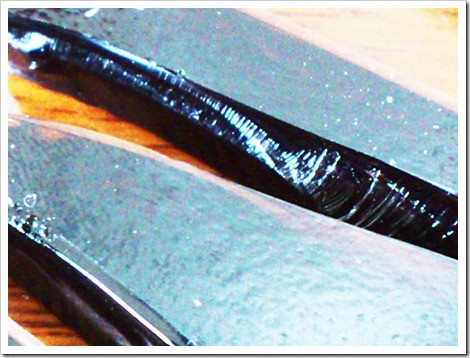
- Anisotropy or directional crystallization. The ability of crystal lattices to change physical properties depending on the direction, i.e. heat quickly warms up in the transverse direction directly under the heat source, remaining almost cold 5-10 cm from the heating zone.
- Low coefficient of thermal expansion, hence resistance to sudden temperature changes. Nothing will happen to glass ceramics, even if cold water is poured onto a heated surface.
- High deformation temperature 1000-1200°.
All of the above is true for products manufactured in compliance with all the norms and rules of the technological process. Unfortunately, to recognize a fake "by eye" will not work. To see the structure of the material, the glass-ceramic coating will have to be broken, but then there will be nothing to talk about.
A conventional gas stove can be a rather nasty potential threat if there are small children in the house, since it heats up in all directions, it is very easy to get burned on it.
Glass-ceramic surfaces ideally conduct heat along the vertical axis and practically do not heat up in the horizontal plane. This means that only the area under the pot or pan heats up significantly during cooking.
How to choose a glass ceramic hob
On sale you can find a large assortment of such devices, therefore, the question arises of how to choose an electric stove with a glass-ceramic surface
It is important to take into account not only the dimensions of the stove or the diameters of the burners, but also some other points. Main selection criteria:
The control of the hob can be dependent on the oven and independent. In the first option, control is carried out directly from the panel, which is located on the body of the oven. Independent ones are more convenient, because they can be installed separately in any place. In addition, the control is mechanical and touch. The latter are more convenient to use. Burner type. They can be rapid, halogen and induction. The first option is the simplest and most common. Induction is the dream of many housewives, because. they instantly heat the bottom of the pan. Additional functionality
Pay attention to the presence of a timer, clock, convection function, grill, etc.
The best induction cooktop
The flagship, innovator and founder of the production of induction devices is AEG.
- But today, on store shelves and on selling websites, you can find a huge number of induction hobs and cookers from other well-known world brands:
- MAUNFELD (high quality and reliability)
- Gorenje (budget and middle price segment);
- Hansa (leader in the production of full-fledged induction cookers);
- Electrolux (absolutely all price segments);
- Zanussi (pricing policy absolutely accessible to the average consumer);
- Siemens (premium models);
- Lex (available models at affordable prices);
- Bosch (quality and reliable).
It is difficult to compare models from different manufacturers, because each company relies on something different from its competitors - design, dimensions, additional functions, etc. Well, now, let's take a close look and discuss the best induction hobs.
Comparison of glass ceramic and induction cookers
Actually, there can be no comparison here, since the very nature of things and their purpose are different. Speaking about induction cookers, we mean, first of all, non-contact heating by an induced alternating magnetic field, and speaking about glass-ceramic electric stoves, in the context of the topic, we mention only the material of the hob, but not the heating source itself.Meanwhile, for induction panels, the hob is also made of the same glass-ceramic, and under the generalized name “glass-ceramic stoves”, completely different electrical devices are hidden, equipped with heating elements, the operation of which is based on various physical principles.
Features of induction heating
Both induction and glass-ceramic surfaces require the purchase of new cookware. Induction surfaces do not work with glass, brass, copper, porcelain, ceramics and aluminium. To check whether the pot you like is suitable for your stove, hold a magnet to it. If it is attracted to the bottom, then the dishes will suit you.
Glass-ceramic surfaces require cookware with a flat, even bottom, and should not be made of aluminum or copper, as these metals leave marks on glass-ceramic.
Increasingly, users of household appliances are abandoning gas panels. Fire hazard, problematic rearrangement of the stove to another place, difficulty in repair - it is these shortcomings that negatively affect such a decision of buyers. To date, the greatest popularity and positive reviews remain behind electric hobs.
Modern design, various colors, mobility in installation and a variety of additional functions significantly attract the attention of users. It remains to figure out which is better - an induction cooker or glass ceramics
